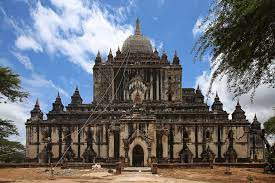Thatbyinnyu Buddhist Temple- Myanmar (Burma)

Address
Thatbyinnyu Buddhist Temple- Old Bagan, Myanmar (Burma)
Diety
Buddha
Introduction
The Thatbyinnyu Temple is a Theravada Buddhist temple in Bagan (Pagan), Myanmar. The temple is recognized as a monument in the Bagan Archeological Area, a UNESCO World Heritage Site. At the pinnacle height of 66 m (217 ft), the five-story Thatbyinnyu is known as the tallest temple in Bagan, alongside the tallest stupa in Bagan, the 100 m (328 ft) Shwesandaw. The temple was badly damaged by the earthquakes of 1975 and 2016. It is undergoing restoration work with Chinese technical and financial assistance; the restoration work is expected to last until about 2028.
Puranic Significance
Thatbyinnyu Temple was founded by King Sithu I of Bagan Dynasty in 1144/45. According to the royal chronicles, it was the king’s second major temple construction after the Shwegugyi Temple, and the king is said to have donated “boatloads of rubies” to both temples. The temple was constructed during “a period of rededication to Theravada Buddhism and religious scholarship”,and construction was completed in 1150/51. Additional ornamentation work continued on the terraces but was never fully completed. The terraces contain indentations that were meant to hold a series of over 500 ceramic plaques depicting the jataka stories but the plaques apparently were never added. The Thatbyinnyu is a five-story brick masonry building topped by a sikhara tower with an hti at the pinnacle. “Somewhat similar to” the nearby Ananda Temple in its architectural style, the temple’s exterior is covered in white stucco, and its terraces paved in stone. The temple was originally at the center of a walled enclosure, of which only the north gate remains. It sits on a platform that is approximately 58 m (190 ft) on each side. The temple exterior resembles a series of square “cubes”, stacked on top of each other, separated by seven receding terraces. Each corner of the terraces is adorned with stupa obelisks on square bases. The elevated central tower, or sikhara, is 30.03 m (98.5 ft) on each side. It is not the tallest structure in Bagan, however; the tallest is the Shwesandaw Pagoda, which is at least 100 m (328 ft) tall, without counting the hti spire. The temple was badly damaged after a 6.8 magnitude earthquake hit the Bagan region on 24 August 2016. It was one of the 36 worst-hit structures, and sustained several horizontal and vertical cracks throughout the structure across all floors, and terraces. Masonry works at the bottom were further damaged by rain. The temple’s structure was reinforced with Chinese assistance in 2017. In April 2019, a Chinese archaeology team began working on a nine-year project to restore the temple.
Special Features
The five-story temple served not only as a place of worship but also as a monastery and library. The temple’s first and second floors were used as the residence of monks; the third floor was used to hold images; the fourth was used as a library; and the fifth stored relics. The interior of the temple consists of “pointed arches in the spacious hallways and barrel vaults in other areas”. Each floor has two tiers of windows, creating a “vibrant and light interior”. Murals filled the ceiling. Original murals with the footprints of the Buddha have survived on the ceiling of the western porch.
Century/Period/Age
1144- 1145AD
Managed By
Department of Archaeology, UNESCO World Heritage Centre.
Nearest Bus Station
Bagan (Pagan)
Nearest Railway Station
Bagan Station
Nearest Airport
Bagan- Nyaung-U Airport




